Before you start raising turkeys you need to decide if you are raising them for Thanksgiving dinner or you’re interested in a more long-term relationship.
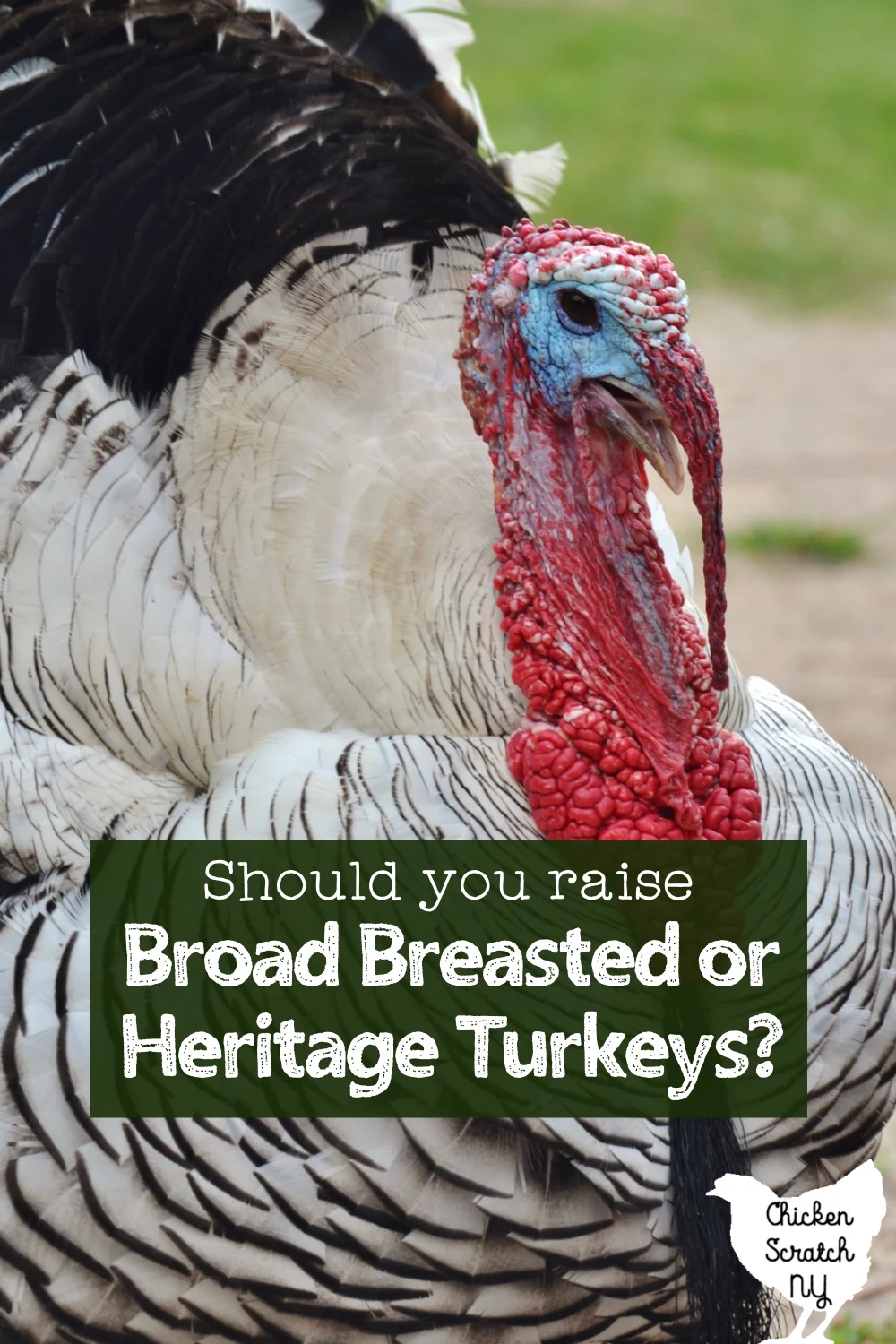
There are two categories of turkeys, the Broad Breasted types, the quick-growing kind raised commercially for Thanksgiving, and the heritage breeds, the slower-growing birds that can naturally reproduce.
Turkey History
Before we get into the breeds let’s talk about the history of the domestic turkey. Please don’t leave! I’m not a history person but this stuff is pretty crazy and very cool.
All domestic turkeys are the same species and are therefore are able to interbreed. They can all be traced back to the eastern wild turkey, Meleagris gallopavo.
Turkeys were originally domesticated in ancient Mexico by the Aztecs and Mayans where science suggests they weren’t raised for meat but for religious purposes.
Turkey remains were found going back to 300 BCE that showed signs of domestication (they were eating food provided by humans, mostly maize) making them one of the earliest animals to be domesticated in the Americas.
The domesticated turkeys were brought to Europe by merchant ships where they continued to be bred, this time with consumption in mind.
Those turkeys, including Black Spanish and the early relatives of the White Holland, were then brought back to the Americas where we did the American thing and made even cooler turkeys like the Royal Palm (Florida) and Bourbon Red (Kentucky).
Of course, we also did the really American thing and ruined them in search of a great Thanksgiving meal. But we’ll get to that later.
See? I told you turkey history was better than regualr history!
Heritage Turkey Breeds
Today we break domestic turkeys down into two groups, the heritage breeds and the two broad-breasted types.
“Heritage turkey” is the term used for the old school birds that are capable of breeding on their own. This is what you are looking for if you plan to keep your birds past their 1/2 birthday.
Read more about Raising Turkeys
The American Poultry Association recognizes 8 different breeds of heritage turkeys. There are other variations, like Midget White, Lavender and Chocolate turkeys that are currently being tracked by the American Livestock Conservancy.
There are also color variations of recognized breeds that are not recognized like the chocolate and slate palms. Just like silver-laced Wyandottes and gold-laced Wyandottes are the same bird wearing a different coat.
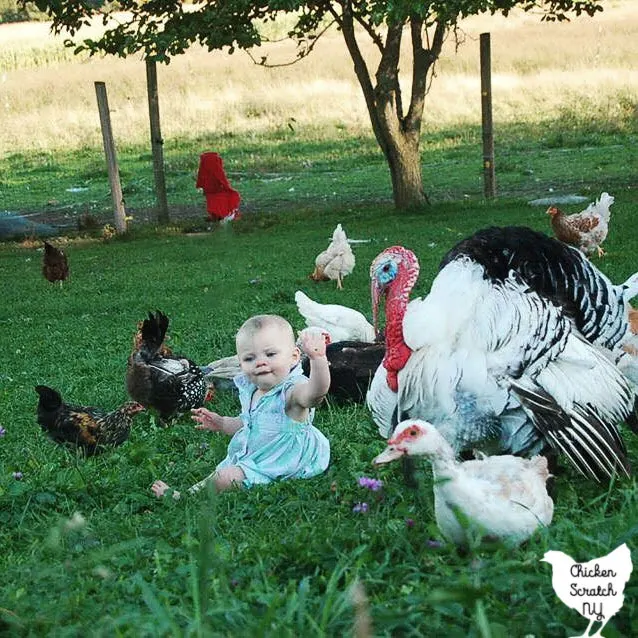
Most of the weights and breed standards I’m using are directly from the 2010 American Standard of Perfection and the American Livestock Conservancy, an organization devoted to preserving heritage livestock including turkeys, chickens, ducks, geese, goats, cows, horses, and donkeys.
Heritage livestock are living history, if you want to help preserve that history all you have to do is raise these birds. It’s the best kind of history (especially when roasted with bacon and maple syrup).
Heritage turkeys including the Royal Palm, Bourbon Red, and Midget White are included in the Ark of Taste from Slow Food International which puts a focus on edible history and draws attention to historical animal breeds along with cultural and traditional foods.
Royal Palm Turkey
Royal Palm Turkeys are the prettiest turkeys you’ll ever find. They are mostly white with dramatic black barring and blue faces.
They are the most ornamental turkey and are largely seen as an exhibition breed. I am currently raising my second flock and they are my favorite birds in the barnyard.
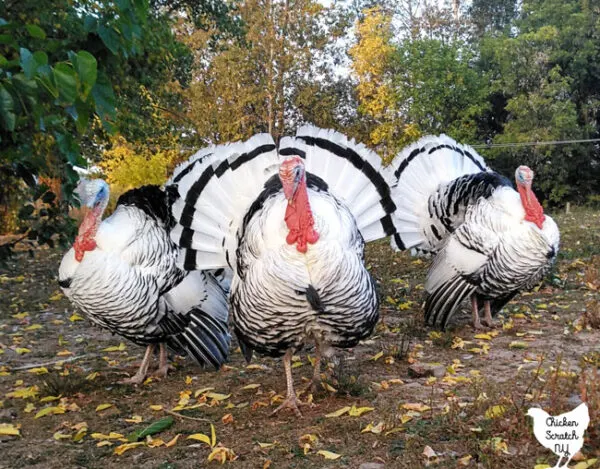
Royal palms are one of the smallest turkeys available, they max out around 22 pounds for old toms, market weight is closer to 16 pounds for males and 10 pounds for hens.
Market weight is the approximate size of the turkey at 6-7 months, or when they would usually be butchered for the table. If you keep your birds as lawn ornaments or as a breeding flock they will get bigger.
They’re a great size for a backyard flock, they don’t need as much room or food as the larger breeds but you still get the turkey experience.
Royal Palms are the most recent additions to the American Standard of Perfection being officially recognized in 1971, the breed comes from Florida where it was first spotted in a mixed flock of Black, Bronze, Narragansett, and Wild turkeys in the 1920s.
The American Livestock Conservancy lists the breed as Threatened, meaning there are fewer than 7 primary breeding flocks and a global population of less than 5,000.
White Holland Turkey
The White Holland turkey, the Standard Bronze and the Narragansett are the earliest turkey breeds to be recognized by the American poultry Association. They were all admitted to the standard in 1874.
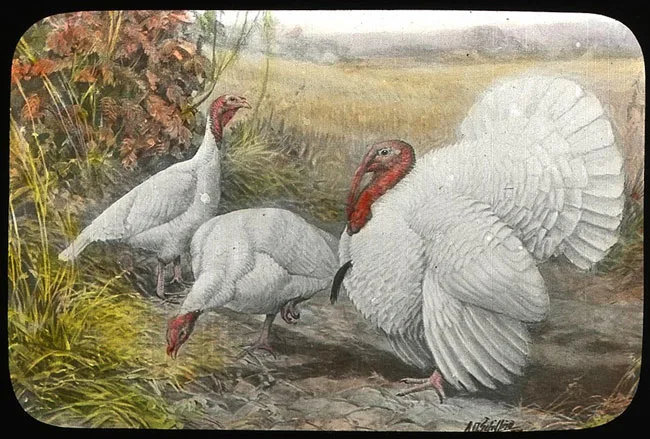
The White Holland Turkey is another breed in the Threatened category. Like many heritage breeds, they were once very popular, in the early 1900’s White Holland were the commercial breed, they fell out of favor when the broad-breasted types were developed and declined in population.
White Holland turkeys can be traced back to the Aztecs where there were selectively bred for white feathers. The turkeys were then imported to Europe (turkeys are native to the Americas) and then brought back to the Americas with Dutch settlers.
In the 1950’s the White Holland was bred with the BB Bronze to create the BB White. Today they are hard to find, especially when looking to meet the breed standard.
White Holland turkeys are, wait for it, white. The all-white birds are large, the standard for adult toms is 36 pounds and 20 pounds for hens. Market weight is 25 and 16 pounds for male and female birds.
Black Turkey
Our final turkey in the threatened category and another with a creative name is the Black Turkey. Like the White Holland, they have a long history. Black or “Black Spanish” turkeys can be traced back to turkeys brought to Europe in the 1500s from Mexico.
The birds made it back to America with settlers where they interbred with wild turkeys for the Black turkeys we have today. They were popular along the east coast where they were selectively bred for calm temperament and rapid growth.

Adult Black Spanish turkeys are solid black, with a green iridescent sheen on the feathers. They may have a yellow tone to the skin, this is more common in birds grown on pasture.
They are similar in size to the White Holland turkeys, mature toms are 33 pounds and hens weigh in at 18 pounds. Market weight is 23 and 14 pounds for males and females respectively.
Beltsville Small White & Midget White
The Beltsville Small White is another small turkey, and the only one listed as critical by the ALBC. There are fewer than 500 breeding birds in fewer than 5 flock and the global population is below 1,000.
The breed was initially developed in Beltsville, Maryland to fit the need for a small commercial turkey in the 1930s. They had a short-lived period of success peaking in the 50s and then disappearing almost completely by the 1970s.
They were noted to have high reproductive success and all the personality traits of a turkey in a large chicken-sized package. Beltsville Small White poults are basically impossible to find in the US but there are breeders in Canada working to bring them back.
If you are looking for a small white heritage breed turkey you will have better luck finding Midget White Turkeys. Midget whites are currently listed under the Watch status by the ALBC.
The breed was developed in the 1960s at the University of Massachusetts by Dr. J. Robert Smyth to meet a commercial need for a small turkey. However small turkeys weren’t in high demand and it never had commercial success.
They were largely maintained at the University of Wisconsin where the breed was standardized by Dr. Wentworth. They are not recognized by the American Poultry Association so they lack the exacting standards you’ll find with other varieties of turkeys.
Midget White turkeys should be pure white and small. They should look like miniature BB Whites with larger breast meat than is found on other white turkeys. Midget Whites have a reputation for being very friendly birds.
The toms should average only 13 pounds and hens being 7 pounds at 8 months old. For reference, adult Brahma roosters weigh 12 pounds.
In an odd twist of fate, in the 1990s many of the Midget White ended up being sent to Beltsville, Maryland. Despite this odd twist, there is no genetic link between the Midget White and the Beltsville Small White.
Bourbon Red Turkey
If you like redheads, this might be the turkey for you. Bourbon Red turkeys are the second breed of turkey that I raised and they are delicious. I picked them because they have a reputation for being good foragers.

Bourbon Reds and the rest of the turkeys I’m going to talk about are listed under the Watch status by the ALBC. There are fewer than 5,000 breeding birds and fewer than 10 primary breeding flocks.
Bourbon Reds are straight out of Kentucky where they were developed in Bourbon County in the 1800s. They were officially recognized by the American Poultry Association in 1909.
They are one of the most unique looking turkeys along with the black and white Royal Palms & the Blue Slate turkeys. Bourbon Reds should have a deep chestnut red color to meet the breed standard but a lighter red color is pretty common.
The chestnut color is found on the body with white flight and tail feathers. It gives them a two-color look that isn’t found in other varieties of turkeys.
The breed standard favors large birds, with mature toms weighing 33 pounds and hens weighing 18 pounds. Market weight is 23 and 14 pounds for males and females.
Over time the breed has shifted towards exhibition over production and the birds have decreased in size.
Slate Turkey
Another beautiful and ornamental breed, the Slate or Blue Slate turkey is a lovely bluish-grey color. Breeding ‘blue’ coloring in poultry is difficult and usually results in a lot of variation from very pale to dark grey-blue.
Offspring from blue parents will have feathers in three styles, blue, splash and black. Splash birds will have white and a less uniform color.
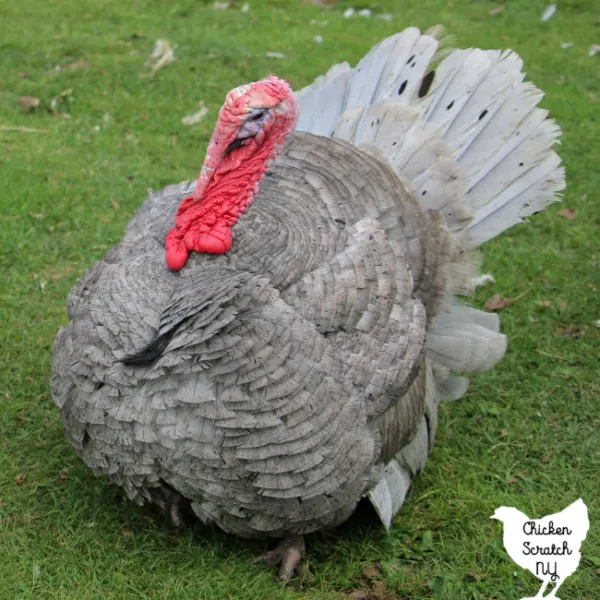
Toms are generally darker in color than the hens. Slate turkeys are large, both adult and market weight are the same as the Black Spanish turkeys.
Standard Bronze Turkey
Out of all of the domestic turkeys, the Standard Bronze turkeys are most similar to the wild turkeys in appearance. The breed was developed by crossing domesticated turkeys brought to America by European colonists with wild turkeys.
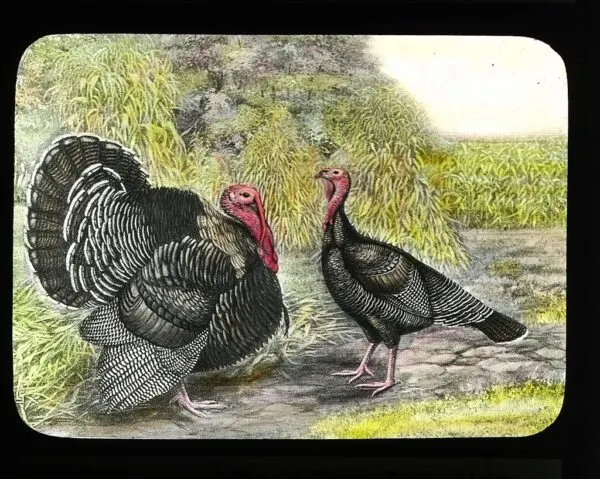
The hybridization led to larger birds that were tamer than wild turkeys. Standard Bronze turkeys are the starting point of the Broad-Breasted Bronze turkey.
Both the standard and the broad breasted bronze turkeys have a beautiful metallic sheen to their feathers. Unlike the BB Bronze the Standard Bronze turkeys are able to reproduce naturally.
Wild turkeys and Standard Bronze have very similar color patterns, if judged side by side the domestic turkey will be larger, have heavier legs (much heavier for the BB Bronze) and the outer most band of color on the tail will be creamy white instead of the brownish tan seen in wild birds..
Standard Bronze are the largest heritage turkeys, adult toms weigh in at 36 pounds while hens are 20 pounds. Market weight is 25 and 16 pounds for males and females.
Narragansett Turkey
Narragansett turkeys and Standard Bronze have a similar history and appearance. The Narragansett turkeys were bred from a cross between the domesticated turkeys from Europe and wild eastern turkeys.
They come from the Narragansett Bay in Rhode Island where they played a critical role in the foundation of the New England turkey industry. In the late 180os Naragansett turkeys could be found in flocks of 100-200 birds, all produced by a dozen breeding hens.
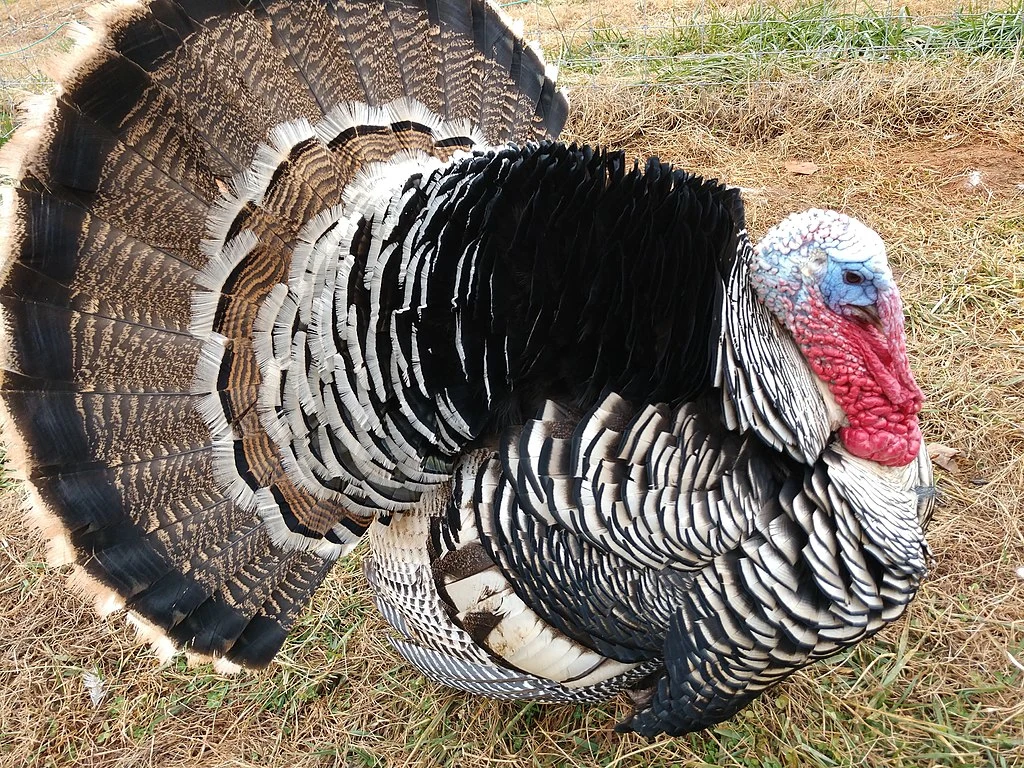
They were raised on pasture where they foraged for most of their food. Like many of the turkeys on this list then began to decline in population when another breed became desireable.
In this case, it was repalced by the Standard Bronze, which would later be replaced by the Broad Breasted Bronze, which was then replaced with the Broad Breasted White.
Narragansett turkeys are big birds, mature toms weigh 33 pounds and hens weigh 18. Market weight is 23 and 14 pounds for males and females.
They are stunning birds, they have a similar color pattern to bronze turkey except that each feather on the chest has a steel grey band with a black tip. The steel grey color is repeated across the rest of the body on both the wings and the tail.
When I was planning my original flock l really wanted to get these guys along with my Royal Palms but they were sold out. I was drown to them because they are known for being good moms with a calm personality.
Broad Breasted Turkeys
If living history and birds than have babies without intervention aren’t your thing you might be interested in the broad breasted turkeys. I’ve mentioned them quite a bit already because most of the heritage breeds were in some way replaced by these two.
I know I’m hating on them but if you’re looking for the fastest route to a succulent turkey dinner you should be looking at the Broad Breasted White and the Broad Breasted Bronze. They are the cornish cross of turkeys.
The Broad Breasted Bronze was developed from the Standard Bronze and the white variation was bred by crossing White Holland turkeys with BB Bronze.

Both the white and the bronze are meant to be eaten asap, they are put all of their energy into putting on muscle and building up that giant breast meat.
Along with the extra chest mass, they have a shorter keep and shorter legs making mating impossible. Fun fact you probably didn’t want to know, every* turkey you’ve ever eaten has been artificially inseminated.
*Unless you’re eating wild turkeys or heritage birds but most people aren’t
The broad-breasted turkeys can be on the table in about 5 months. Toms will weigh in around 34 pounds and hens will be smaller at 22 pounds.
They grow quickly and eat a lot of food, if you plan to eat your bird on Thanksgiving aim to start your poults (baby turkeys) in late June to Early July. You will want to butcher your turkey at least 2 days before the big day, you’ll need more time if you plan a longer brine.
The difference between the BB bronze and BB white is the feather color. The bronze type was the original color variation and it was largely replaced by the white turkeys in commercial operations in the 1960s.
White birds have a cleaner appearance after being plucked (because most people don’t like any reminder that the bird they’re eating was once alive) are favored for that reason.
BB turkeys have a milder flavor and much more white meat than heritage birds thanks to that giant breast.
I’ve never raised the broad-breasted types, I’m a big fan of sustainability and being able to raise my own replacements.
Check out my Livestock page for more info or start here:

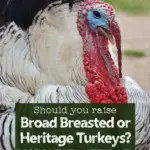


Annie
Friday 6th of August 2021
Great article!